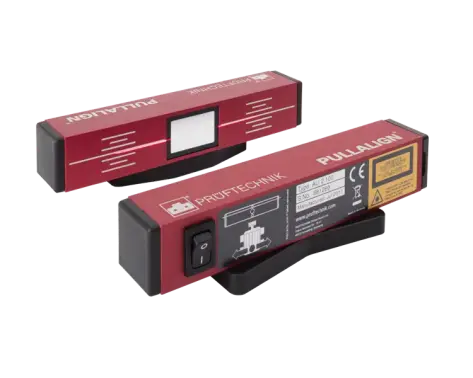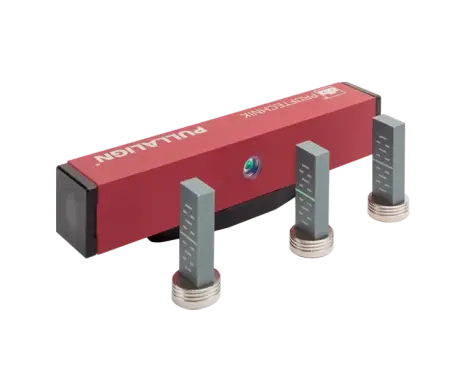Laser Belt Alignment Tools - Belt & Pulley Alignment
Pruftechnik PULLALIGN belt alignment tools empower you to perform quick, high-precision laser alignment, preventing breakdowns and maximizing machine lifespan. Correcting belt pulley alignment significantly extends machinery service life and lowers power consumption by decreasing wear and improving efficiency. While you can identify misalignment visually or with a straight edge, using a pulley alignment laser tool makes finding angular, vertical, and horizontal misalignment much faster and easier. Our laser belt alignment tools and pulley alignment tools are easy to use and can pay for themselves within only a couple of months.
Frequently Asked Questions
Belt misalignment of the driving and driven pulleys is by far the most common and damaging installation error that occurs on belt. Belt misalignment is not usually due to carelessness on the part of the installer. Belt alignment problems are more often due to a lack of suitable tools with which to carry out the required alignment.
For many years, at best, a tight wire or straight edge were the only belt alignment tools available. Both methods rely entirely on the installer’s eyesight to ensure that the belt alignment is correct. Neither method has any measurements documented. Both rely upon the installer adjusting the driven pulley until the faces or grooves of the driven pulley touch the surface of the straight edge or tight wire. The driven pulley is then rotated half a turn and then rechecked and adjusted. The measurement is then repeated until the pulleys appear to be in line. No angularity or inaccurate mounting of the reference line is measurable. The system is purely an estimate of the alignment of the two pulleys.
What are the Main Types of Belt Misalignment
There are three basic parameters that describe pulley misalignment. These are vertical angularity, horizontal angularity and axial offset. These conditions usually occur in any or all combinations of belt alignment condition.
What Tools do you Need to Align a Belt and Pulley?
There are two different methods used to achieve pulley alignment and belt alignment on rotating machinery. The less advanced method uses mechanical tools such as a straightedge, feeler gauge, tape measure, wire, string, spirit level, or calibrated cone. This traditional method might be quicker, but it does not ensure accuracy.
A more advanced method uses pulley alignment with laser technology to take reliable, accurate readings. A laser pulley belt alignment tool makes it easier to identify misalignment and maximizes measurement efficiently.
How do you Check Belt and Pulley Alignment?
You check for belt and pulley misalignment using either handheld tools such as a straight edge or a pulley and belt laser alignment tool.
Why is Pulley Alignment Important?
Pulley alignment is critical because when a pulley is misaligned, it causes additional load on machinery. Laser pulley alignment decreases vibration, prolongs belt and bearing life, and reduces vibration, noise, and energy consumption.
Benefits of Belt and Pulley Alignment
Reduces premature belt wear
Cuts energy consumption
Decreases machine vibration
Leads to improved machine performance
What Are the Most Used Methods to Align Belts and Pulleys?
The most common methods used for aligning belts and pulleys are hand tools such as a straight edge or feeler gauge, a laser pulley alignment tool, or a belt alignment system.
Benefits of Using Laser Alignment to Align Belts and Pulleys
A laser pulley alignment tool is easier to read and increases alignment accuracy. Proper pulley and belt alignment prolongs machine life substantially and decreases power consumption by reducing belt and pulley wear and improving asset performance.
What Is Belt Alignment?
Belt alignment is a key aspect of keeping your operation up and running. When your belts and pulleys are misaligned, it creates an additional load on equipment. Over time this leads to excess wear and tear, reducing the lifespan of your assets. Left uncorrected, misaligned belts and pulleys can lead to breakdowns and can seriously impact your productivity.
It’s a good idea to measure belt alignment (and pulley alignment) regularly, so that you can get ahead of any new alignment issues. Today’s modern belt alignment tools make that easy. Laser belt alignment tools, and laser pulley alignment tools, are a simple, cost-effective way to fix your alignment issues.
Watch the videoWhat Is Laser Belt and Pulley Alignment?
Laser belt and pulley alignment is a straightforward, modern method for fixing alignment issues. It’s easy to implement, even if your maintenance teams don’t have a lot of technical expertise. It’s also highly precise and can catch minor alignment issues early, before they become serious.
The old fashioned way of fixing pulleys relied on tools like feeler gauges, string, and straightedges to check alignment. That approach is not accurate enough for today’s precision assets.
Laser alignment tools use laser beam precision to catch even the slightest problem in your belt and pulley alignment. With today’s assets, small belt alignment issues make a difference. And catching misalignment early lets you nip the problem in the bud, saving you resources down the line.
What Are Belt and Pulley Alignment Tools?
The oldest belt alignment tool is the human eye. Dial indicators, wires, and rulers have also been used to check alignment.
The best modern approach to fixing belt alignment, or pulley alignment, is a laser alignment tool. Laser belt and pulley alignment tools can align pulleys and pulley grooves. They are easy to use and come with a user-friendly interface, guiding teams through the process of taking measurements and correcting misalignment.

 Fluke Reliability Solutions
Fluke Reliability Solutions 


